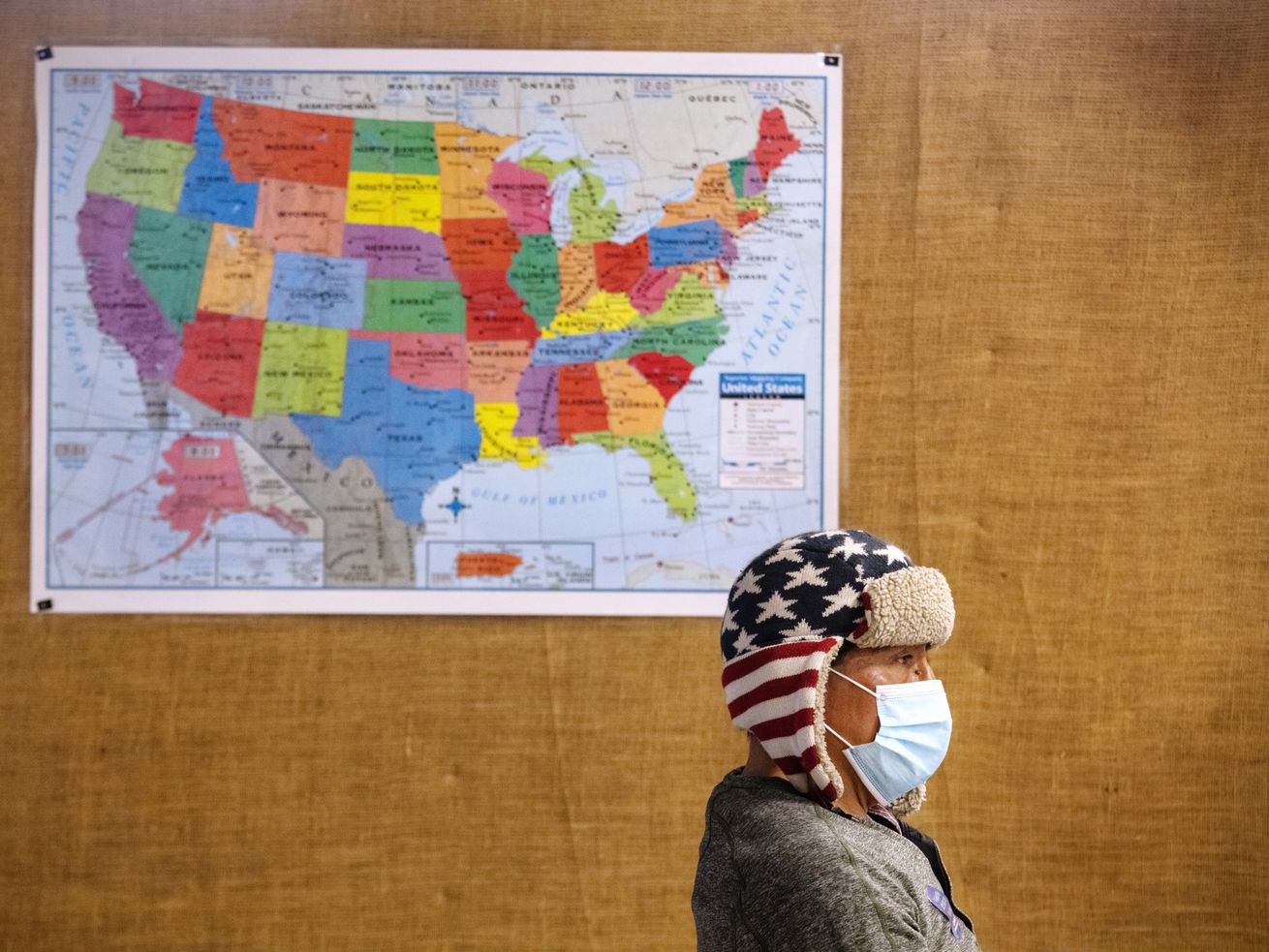Covid-19 outbreaks in ICE detention have made vaccinations more urgent.
Despite the widespread availability of vaccines in the US, the vast majority of immigrants held in detention in the country still haven’t received their first shot — allowing Covid-19 to spread through some detention facilities largely unchecked.
As of last week, 8,221 immigrants in US Immigration and Customs Enforcement (ICE) custody, or roughly 30 percent of the detained population, had received one dose of the vaccine, CBS News reported. Just over 1,300, or about 4 percent, had received two doses. (The agency has not indicated how many immigrants have refused the vaccine or have received the Johnson & Johnson vaccine, which is just one dose.)
That represents an improvement from May, when just 20 percent of people in ICE detention were inoculated. But the vaccine rollout has proved too slow to keep up with the rising number of immigrants in detention, which has nearly doubled since Biden took office, and the resulting outbreaks of Covid-19.
There have been more than 19,000 Covid-19 cases in ICE detention and nine related deaths since the onset of the pandemic. As of Monday, there were 921 active cases across 51 ICE detention facilities nationwide. Some of the worst outbreaks are occurring in Arizona, Texas, and Louisiana — states with lower than average vaccination rates overall.
Experts say the spike in Covid-19 cases could have been mitigated if the Biden administration had directed ICE to play a more active role in administering vaccines instead of deferring to state and local authorities, especially in red states where there is little appetite for prioritizing immigrants, or pushing for vaccines at all.
Coupled with the recent ballooning of the population of immigrants in ICE detention, the delay in the vaccine rollout has allowed the virus to continue to threaten this already vulnerable population.
The Biden administration can turn the situation around, but the task has become especially urgent given the onset of the highly transmissible delta variant of the virus. To address the disparity, experts say the administration needs to develop a nationwide plan to quickly administer vaccines to any ICE detainees who want it, work to combat vaccine hesitancy among immigrants who don’t trust detention facility medical providers, and consider releasing immigrants from detention.
ICE is beginning to take some of these steps, but progress can’t come soon enough.
“The federal government has plenty of vaccines and very effective tools at its disposal, if it were inclined to make this a priority and protect people,” said Aaron Littman, who has been tracking vaccinations in ICE detention as the deputy director of the COVID Behind Bars Data Project at UCLA School of Law. “The results of not doing that have been pretty dire.”
“There is a vacuum of anyone taking responsibility”
ICE presides over a network of detention facilities nationwide, most of which are run not by the agency itself, but by contractors including private prison companies and county jails.
Until recently, the agency has used that as an excuse to cede responsibility to state and local authorities to vaccinate immigrants in its custody, as opposed to running its own vaccination campaign. In court filings, the agency has argued that it would not be able to deliver vaccines to all detainees, claiming that it “does not have medical authority” over the detention centers that are not staffed by its Health Service Corps.
That’s in contrast to the Federal Bureau of Prisons (BOP), which obtained its own allocation of vaccines and has overseen the effort to vaccinate more than 82,000 people, or about 57 percent of the federal prison population.
The disparity between ICE and BOP’s response is even more striking given that immigrants are being detained on the basis of civil immigration violations — such as overstaying a visa or entering the US without authorization — as opposed to criminal charges. In most cases, detained immigrants pose no public safety risk and could be released at the Biden administration’s discretion.
“There is a vacuum of anyone taking responsibility,” Littman said. “The onus is on the federal government, whether or not [immigrants in detention] are being held pursuant to a contract with somebody else. They would be free to get a vaccine at CVS like anyone else but for the federal government’s decision to incarcerate them.”
ICE’s decision not to take the lead on vaccinations has resulted in wide disparities in vaccine rollouts in detention centers across states. Though ICE has not made state-level vaccination data publicly available, immigrant advocates have reported that detention centers in certain states aren’t offering the vaccine at all.
That includes the La Palma Correctional Facility in Eloy, Arizona, which has seen one of the worst outbreaks nationwide, said Sofia Casini, the director of visitation advocacy strategies at Freedom for Immigrants, which advocates on behalf of immigrants in detention.
Her organization has also spoken to people who were recently released from ICE detention in Adams County, Mississippi, who say they were never offered the vaccine, despite the local public health department’s statements to the contrary.
ICE has recently changed course: It has obtained its first allocation of 10,000 vaccine doses and nationwide distribution is underway, according to an agency spokesperson. Future allocations will be replenished on a rolling basis. It also recently began administering the Johnson & Johnson vaccine as part of a “department-wide effort to scale vaccine uptake in ICE facilities, to complement efforts at the state and local levels,” the spokesperson said.
“DHS remains committed to a public health guided, evidence-based approach to vaccine education that ensures those in our care and custody can make an informed choice during this global pandemic,” they said. “The Covid-19 vaccine is the most effective way to protect all our communities from the disease and control the pandemic.”
However, ensuring that immigrants in detention are willing to get the vaccine and that they can give informed consent to do so is another hurdle.
ICE has historically offered inadequate medical care
ICE has a long track record of providing substandard health care to immigrants in its custody.
Over the course of the pandemic, the agency has failed to comply with its own pandemic response requirements, neglecting to give detainees access to soap, masks, texting ability, and isolation. And in one high-profile case last year, detainees at a facility in Ocilla, Georgia, claimed that a doctor performed unwanted hysterectomies and other medical procedures on them.
A recent University of Southern California study of 55 deaths among people in ICE custody between 2011 and 2018 also found that the agency violated its own internal medical care standards in 78 percent of the cases the researchers examined. Detention center staff often delayed medical care or failed to respond to detainees’ abnormal vital signs, such as elevated heart rate and blood pressure, even in some cases where subordinate officers raised concerns about the detainees’ health. On average, the detainees were just 42 years old when they died, leading the researchers to conclude that the health care decisions made by detention center staff could have contributed to their untimely deaths.
The lack of adequate health care has led some immigrants in detention to be wary of getting the vaccine because they do not trust medical providers and have not been provided with information about the vaccine in their own language.
“Many people are calling into our national reporting hotline saying that they’re scared to get the vaccines,” Casini said. “They’ve been abused by these medical professionals. So they don’t trust that they’re even getting the correct vaccine, combined with the fact that they see people who may have adverse reactions to vaccines, like passing out, and those people are not being given appropriate medical care.”
“The heart of this is just the complete substandard health care, and the abuse of people’s medical rights, which is an ongoing issue inside of ICE detention,” Casini said.
The Biden administration can do more to ensure ICE detainees are being vaccinated or released
Going forward, the Biden administration can improve vaccination rates in ICE detention by allocating more vaccines to the agency. The structure of ICE’s network of detention facilities operated by various contractors makes the process of administering those vaccines more challenging than it was for the BOP, but it’s not impossible.
“There’s a little more bureaucracy involved, a little more paperwork involved, but is not a legitimate reason that anything should have happened more slowly. And it’s kind of smoke and mirrors to suggest that there’s some legal obstacle,” Littman said.
ICE can also require that detention facilities procure and administer vaccines promptly as part of their contracts with the federal government, Littman said.
To address vaccine hesitancy, ICE should initiate a campaign to educate people held in its facilities about the benefits of the vaccine and the potential adverse side effects they might expect. Immigrant advocates also suggested that independent medical providers, such as community health centers, be brought in specifically to administer vaccines. That would help mitigate some of the detainees’ fears, Casini said.
But at the same time, the Biden administration needs to consider reducing the population of immigrants in detention, which has trended upward in recent months. That has made it difficult for detention centers to enforce social distancing measures. And until every immigrant in detention who wants the vaccine can get it, they will be at risk.
“Vaccination is obviously critical, but we need to see detention numbers trending down,” said Setareh Ghandehari, the advocacy director for Detention Watch Network, which advocates on behalf of immigrants in detention. “We’re at an especially critical moment with the pandemic, and continuing to irresponsibly grow the number of people in immigration detention impacts not only the lives of the people that are detained, but it also is going to have an overall impact on the state of the pandemic.”
Author: Nicole Narea
Read More



